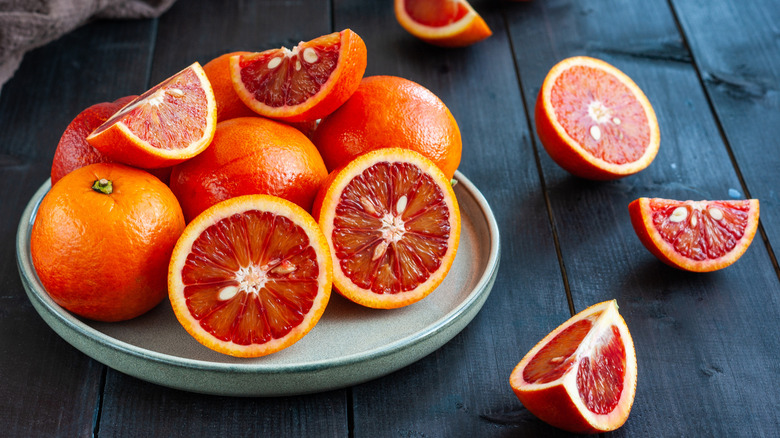The Ancient Sicilian Origins Of The Delectable Blood Orange
One glance at a blood orange and it's clear just how unique this beautifully-colored and epically-named this fruit is. There are several different varieties of blood orange, with flesh that varies between pink and such a deep red that peeling and eating one will leave your hands stained (don't worry, it washes off). But still, they tend to only grow in specific areas of the world. Most blood oranges come from areas like northern Spain, California, and Italy, which makes sense: They're a centuries-old fruit that was once a prized delicacy in their native Sicily, now used in cocktails like the blood orange French 75 and the blood orange margarita.
Some of the world's best blood oranges still come from Sicily, where factors like a dry climate, sunny days, cool nights, and fertile soils all combine to create their perfect growing environment. Every year, the arrival of February heralds the beginning of the blood orange harvest, which is such a big deal that it's celebrated with a dedicated festival called the Sagra dell'arancia rossa. They've been a staple of Sicilian agriculture for centuries, with the earliest records dating to the 9th century.
Blood oranges were once reserved for royalty and immortalized in literature
Sicily was a part of the Roman Empire for several hundred years, serving as an important source of food. But blood oranges didn't emerge until the region fell under Arab control between 878 and 1061. Even at the time, the fruit was recognized for its relative rarity, prized for its deliciousness, and reserved only for those fortunate enough to live in the upper echelons of society. As such, they were also an invaluable bargaining tool.
In 1016, Norman lords kicked off an invasion of southern Italy. As the story goes, the invasion came in response to a plea from the prince of Salerno. Desperate to find allies that would help free the area from the control of their Muslim rulers, the prince showed the Normans blood oranges as an illustration of what sorts of treasures the area held.
Blood oranges have shown up in historical texts dating back to 1646, which described blood oranges that had made their way to the Philippines. But, perhaps more interesting are the mentions of blood oranges in fairy tales and fiction. In a version of "Cinderella," the heroine is given a gift of blood oranges, and they get a passage in "Arabian Nights" as well: "And in that garth (garden) grew blood oranges ... Red fruits that fill the hand, and shine with the sheen of fire."
Blood oranges grow only in specific climates, and we know why
Given the popularity of blood oranges, it's almost surprising that they haven't spread much beyond the relatively specific areas known for growing them. But it was only in 2012 that research published by the American Society of Plant Biologists determined the reason for their specific needs, and it all has to do with the pigment that gives them their unique color.
That pigment, anthocyanin, is made by a gene researchers nicknamed Ruby. This gene — which is also found in other types of oranges — is kick-started into producing the red coloring by stress on the plant. Researchers found that the cold nights that alternate with the warm days in places like Sicily provide just the right amount of stress that encourages the development of anthocyanin, the intensification of which produces the blood orange's distinctive color.
Anthocyanins are about more than just the color of the orange, though. They contain powerful antioxidants, one of which — chrysanthemin — has been linked to preventing the growth and spread of certain types of cancer cells, according to Healthline. Blood oranges are also rich in vitamins and nutrients and have been linked to weight management, preventing common complications from pregnancy (like preeclampsia and diabetes), and improving gut health and immune system function.


